
Image Source
One of the most extensive studies conducted by Janet Colvin, Nancy Tobler and James A. Anderson in 2004 among 180 academics, leaves no doubt about the productivity results of working with two screens.
Participants received five minutes of training before starting their work on multiple screens. All participants worked for one hour on a single screen and then another hour on two or even three screens. Half of the group worked from two screens and half worked from three screens.
The task was actually really simple to correct Word texts, PowerPoint sheets, and Excel spreadsheets. The results showed a clear improvement in performance: a 10% increase in productivity at the same time and 33% fewer errors. The study also concluded that adding a third screen did not improve results.
In all similar studies, between 90% and 98% of participants did not want to return to a single screen.
There are studies that show a 10% increase in productivity and others that show an increase of up to 50%. It all depends on the tasks at hand. Some employees will benefit more than others.
So, when does it become interesting to use two screens instead of one?
The study conducted by Colvin and his colleagues shows that a second screen is a good investment leading to better performance as long as the user spends more than 21% of his time collecting information from multiple sources. But given that the price of screens has been steadily declining since 2004, the break-even point is now probably well below 20%.
Table of Contents
Some of the advantages of dual monitors are:
- Manage several tasks at the same time
- Compare or copy documents
- Keep an eye on a watch service or a messaging service
- Reconciling two uses
Bigger is not necessarily better
Another study, conducted by the University of Utah, was intended to build on the work of Colvin’s team. It looked at the effects of screen size and number of screens on user performance.
In addition to the common screen sizes of 18 to 22 inches, the team was interested in wide screens with diagonals of 22, 26 and 30 inches that allow two pages or applications to be displayed side-by-side on a single screen.
It was clear that there is a direct link between screen size and time savings. The larger the screen, the greater the time savings. We already know that time is saved by using two screens instead of one. This study has shown that the maximum time saving is obtained with a 26-inch widescreen or with two 20-inch screens. In both cases, productivity increases by more than 40% compared to a single 18-inch screen.
Ergonomics
Human beings are adaptable… for better or worse. Many people will adapt without question to a physical environment that is far from optimal, and harm may result. Ergonomics is first and foremost about adapting the physical environment as best as possible to the person using it.
Screens should be of the same design. They should also be absolutely detached from the keyboard and their angle of inclination and height should be easily adjustable.
Two aspects are essential with regard to the optimal layout of the screens: the angle of the screens in relation to each other and to the user, and the viewing distance. Using a dual monitor stand enable you to adjust your monitors freely above the desk for better positioning and more comfortable viewing angles
Working on two 22″ or 24″ screens while respecting the rules of ergonomics requires a viewing distance of approximately 80 cm (70 to 90 cm above). If the distance is too small, you will have to use a support arm for the screens, unless you replace the desktop .
A sufficiently large screen and an optimal screen layout can alleviate much of the muscle tension mentioned above. A balance must therefore be found between the health consequences and the gain in productivity.
Here are the main lines. For the rest, it depends! If you are using a main screen to process documents and a secondary screen for the formatting palettes and add-on software, the main screen should be located right in front of you and the secondary screen should be located to the right or left of you. The screen size is preferably 19″ or larger so that the neck angle is kept to a minimum for optimal performance.
If you spend more than a third of your time processing data from multiple sources, it is best to arrange the screens symmetrically in front of you.
A significant effect of the use of two screens is the reduction of prints. Indeed, instead of comparing a document displayed on one screen with a printed copy, it is generally easier and more efficient to compare the two versions on screens arranged side by side. Not to mention the fact that the editing is done directly in the computer document, so there is no need to transcribe the changes into the document.
In summary, the use of two or three screens provides these advantages:
- Increased productivity and reduced errors
- Better ergonomics and more fun at work
- Greener option due to lower paper consumption


